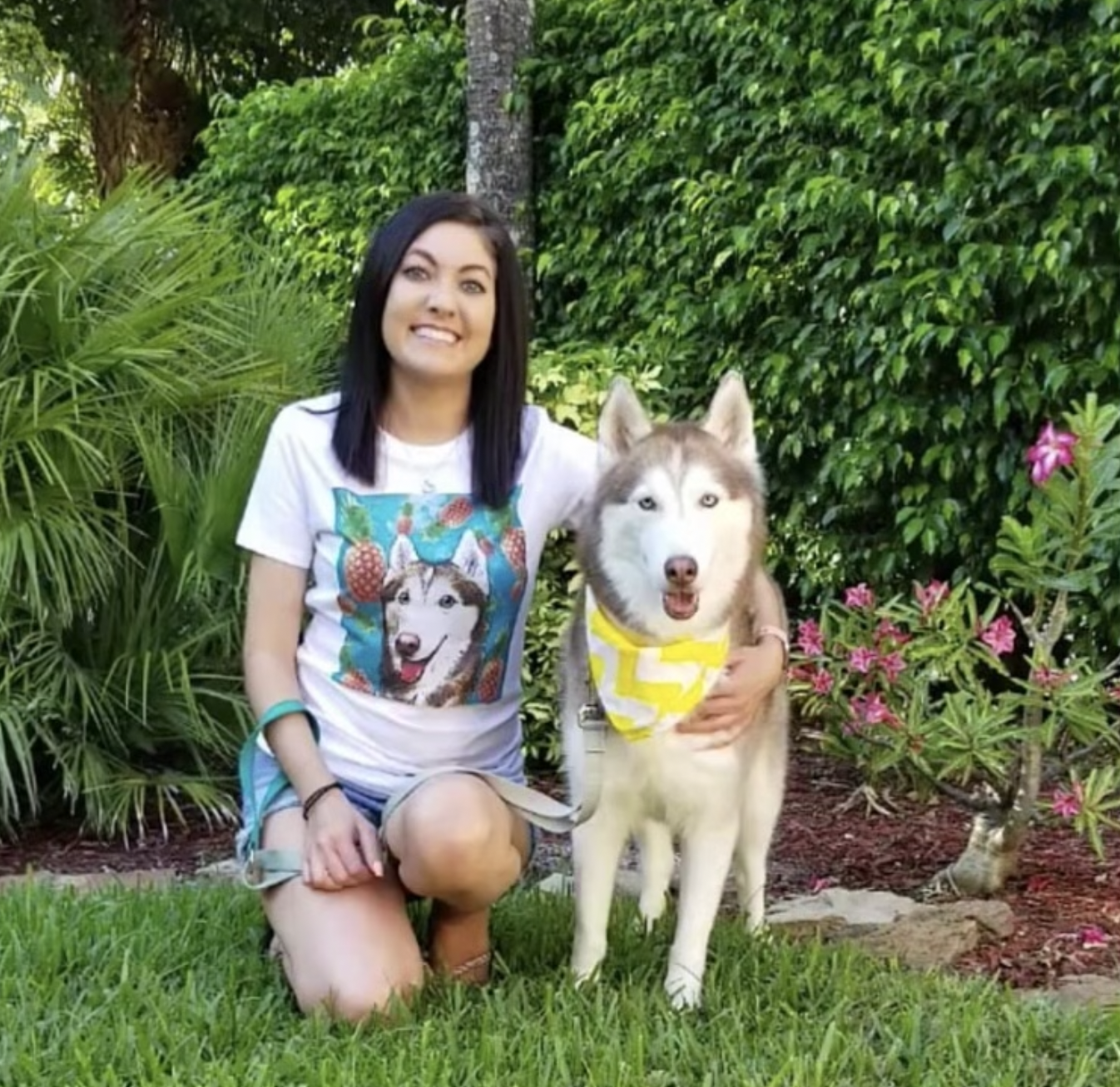For Pups With Short Attention Spans…
Newborn puppies get their baby “deciduous” teeth between 3-5 weeks of age. Puppy teeth begin to fall out around 14 weeks of age, and a full set of adult dog teeth is expected by 6-7 months of age. Keep your vet informed about your pup’s teeth and keep an eye out for issues such as underbites, retained teeth, and overcrowding
Somehow puppies ended up super soft, with the teeny-tiniest toe beans, roundest bellies, sweetest puppy breath… and crazy-sharp puppy teeth. These little daggers definitely come equipped with finger-and toe-seeking technology, and you’ll feel every little nip until their adult teeth grow in.
When Do Newborn Puppies Get Their “Puppy” Teeth?
Much like human babies, newborn puppies don’t have any fully erupted teeth—a.k.a. teeth that are visible above the gumline. This way the puppy can nurse in the first few weeks without causing Mom any pain. It isn’t until around 3-5 weeks old that the first few puppy/shark teeth—also called deciduous teeth—begin to appear.
Their full set of 28 mouth-needles usually grow in completely by around 6 weeks old1.
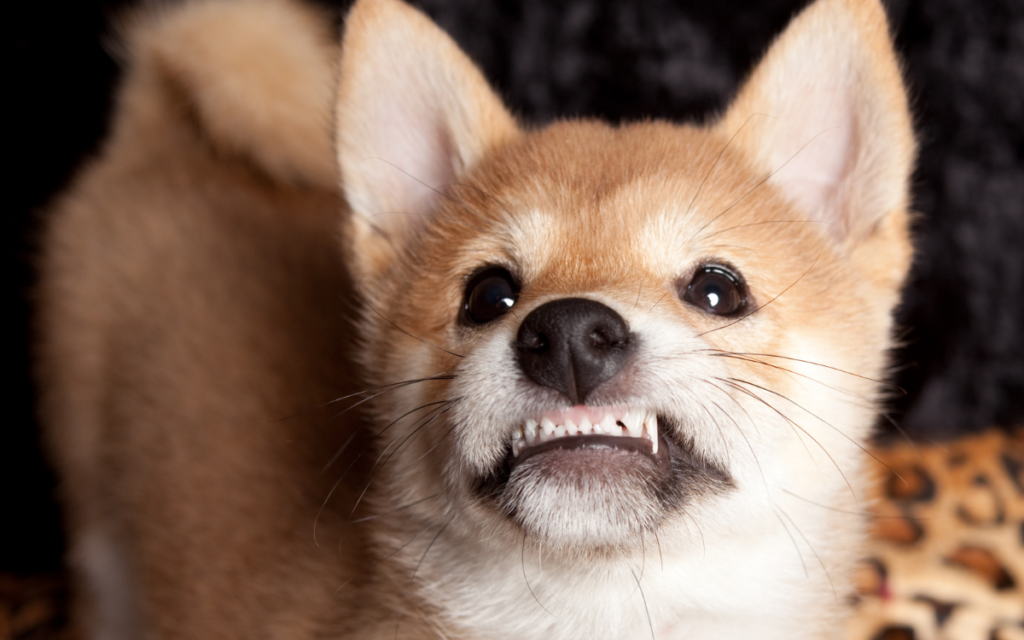

The teeth you’ll likely notice first are the incisors (the adorably small front teeth) and the canines (the longer fang-like teeth)2. Although the timing of puppy teeth coming in can differ by breed, a still-missing tooth around 12 weeks old may be a sign that their permanent tooth is unlikely to ever come in3.
(Please don’t judge them for this! It’s called a fashion statement and it’s adorable.)
Typical Deciduous (Baby) Teeth Eruption Schedule
| Incisors | 3–5 weeks |
| Canines | 3 weeks |
| Premolars | 4–12 weeks |
When Do Puppies Lose Their Puppy Teeth?
A puppy’s first set of deciduous (baby) teeth will slowly fall out around 14 weeks old to make way for their larger, stronger adult teeth. (Don’t be surprised if you find little teeth around the house! They’re worse than stepping on Legos.)
If you happen to find a rogue puppy tooth without the root attached (just the crown) don’t freak out! The tooth has not broken, the roots have actually just reabsorbed in the mouth. If your puppy swallows a puppy tooth instead of spitting it out, that’s also totally normal. Their bodies can handle it fine—plus, bonus calcium!
By the time a puppy reaches 6–7 months old, all their puppy teeth should have fallen out and been replaced by adult teeth1.
When Do Dogs Get Their Adult Teeth?
As puppies lose their baby teeth, their permanent, adult teeth simultaneously take their place. The timing of tooth replacement varies depending on breed; larger breeds usually get their adult teeth sooner than smaller breeds. Adult teeth typically begin to appear around 3 months old.
As permanent adult teeth replace your puppy’s 28 baby teeth, they will also grow additional molars to complete a full set of 42 permanent teeth1. Theses molars typically come in later, around 5–7 months old.
Typical Adult Teeth Eruption Schedule
| Incisors | 3–5 months |
| Canines | 4–6 months |
| Premolars | 4–6 months |
| Molars | 5–7 months |
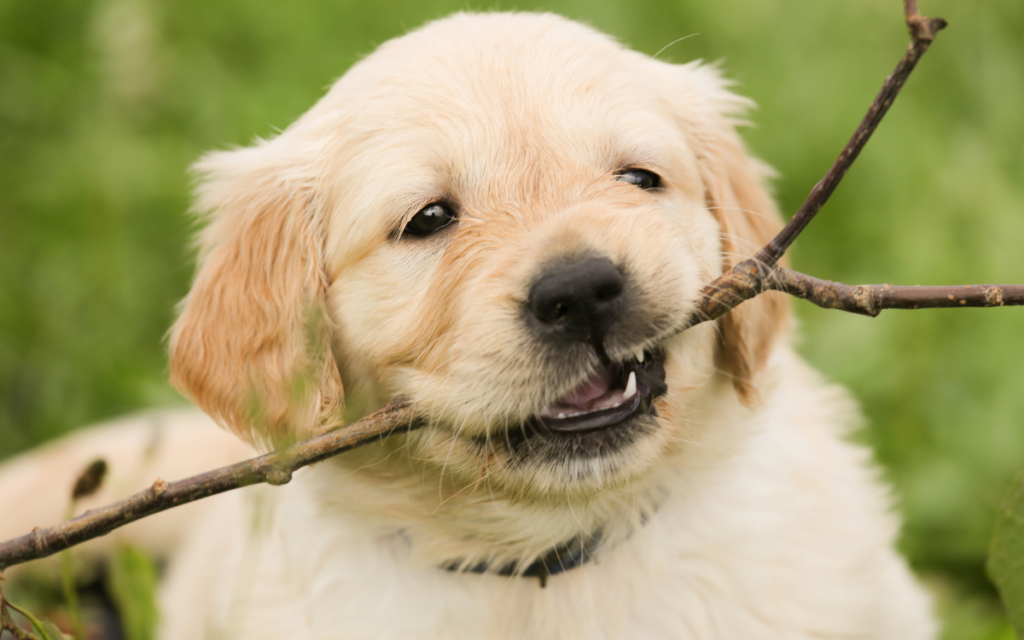

What Are Some Puppy Teeth Problems To Watch For?
Although most puppies have no problems during the stages of tooth growth and change, below are a few mishaps that can occur and need to be addressed by your veterinarian. Certain issues are more likely to appear during particular stages of dental development.
Overbite Or Underbite Developing In Puppies (First 16 Weeks)
Overbites or underbites can develop within the first 16 weeks1. Although we’ve all likely seen some adorable bulldogs and other breeds with an underbite/overbite, it can cause problems for pups. If caught early, your vet will usually recommend extracting (removing) certain puppy teeth to prevent future problems with your dog’s permanent adult teeth and jaw alignment. Misaligned baby teeth can “trap” a jaw into a specific bite position, thus preventing the upper and lower jaw from growing in sync1.
Incorrect Position Of Puppy Tooth Or Extra Puppy Tooth (First 16 Weeks)
Another issue that may develop in the first 16 weeks is teeth popping up in incorrect positions, or even extra teeth coming in. Your vet may recommend extracting these teeth if they’re interfering with other teeth or causing discomfort1.
Puppy Teeth Not Falling Out (16 Weeks–7 Months)
Any puppy teeth that don’t fall out on their own are called retained deciduous teeth, or persistent teeth. The adult tooth meant to replace a retained puppy tooth usually still erupts, which can cause overcrowding in the mouth. That often leads to plaque buildup and early periodontal disease due to food and bacteria getting trapped between the puppy tooth and adult tooth occupying the same “parking spot” in the mouth.
Typically, puppy teeth that remain after 6 months of age are considered retained. Ideally, puppies should be examined by a vet around this age to identify retained teeth and make a treatment plan to avoid future dental issues1. Veterinarians will likely recommend these teeth be pulled to avoid compromising the long-term health of the adult tooth and any problems with occlusion (the “bite” alignment).
Abnormally Tilted Canines In Puppies (16 Weeks–7 Months)
Occasionally, puppies’ canine teeth grow in at the wrong angle—this happens more often in Shetland sheepdogs and smaller breeds. Your veterinarian may recommend treatments like “doggy braces,” a special mouth plate, tooth shortening, or extraction to correct the situation1. (You wanted to see more pics of doggy braces, didn’t you?)
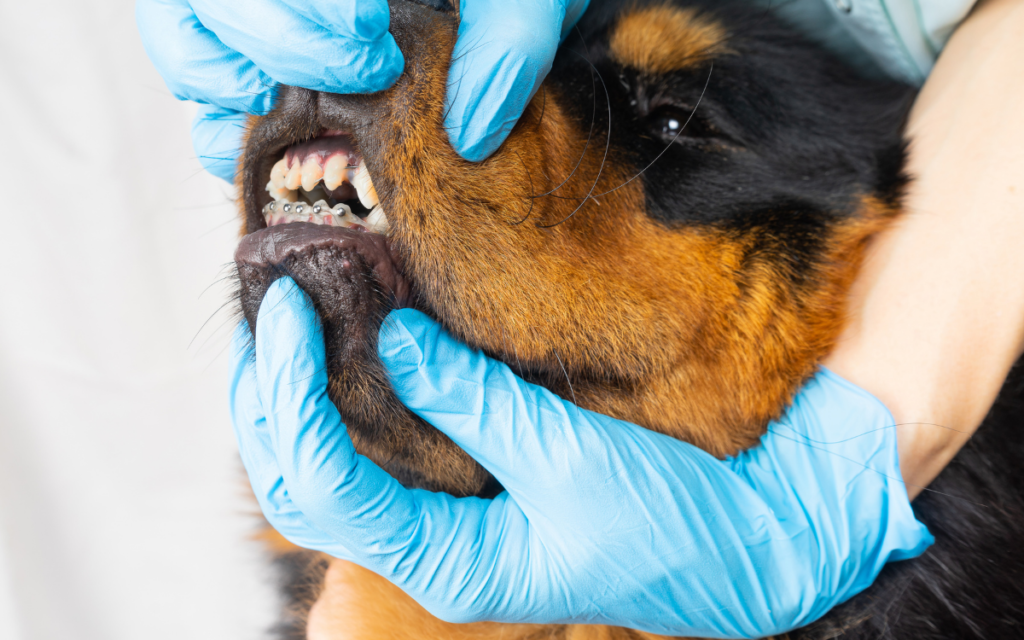

Base-Narrow Canine Teeth (16 Weeks–7 Months)
Sometimes the puppy or adult lower canine teeth of a dog can be “base-narrow.” This means that the distance between the tips of the right and left lower canine teeth is shorter than it should be. When the mouth closes, these lower canines actually bump up against the roof of the mouth.
This repetitive bumping will essentially make holes (deep ulcers) in the roof of the mouth, which hurts! Once again, extraction usually resolves this, especially if the offenders are puppy teeth. Vets then monitor the eruption of the adult teeth closely.
For adult base-narrow canine teeth, sometimes a veterinary dentist can perform a special procedure to shorten the canine teeth or introduce an orthodontic “retainer,” so that they don’t cause any more damage to the roof of the mouth.
Incorrect Tooth Placement Or Overcrowding (7 months–5 years)
Additional problems with crooked teeth, incorrect tooth placement, or general overcrowding may occur within the first year and a half, especially in flat-faced breeds like pugs or bulldogs. Watch this closely, because malpositioned teeth can cause abnormal wear against other teeth, or permanent contact-ulcers on the gums. Your vet may recommend frequent X-rays, a tooth extraction, or other orthodontic procedures1.
Teeth Not Growing In
Although this can happen in any breed, flat-faced dogs and other small breeds sometimes have issues with their teeth not growing in. If all your dog wants for Christmas is the rest of their teeth, they should be monitored carefully with x-rays during the puppy’s first year as their teeth develop.
If the adult tooth doesn’t erupt and remains under the gumline, it will most likely need to be extracted to avoid causing tooth decay or infection in the jaw1.
Enamel Defects
Enamel defects can develop with both puppy and adult teeth. Sometimes this is caused by viruses like canine distemper or other diseases that attack the cells that produce tooth enamel. Malnutrition and hereditary factors can also produce defects in the enamel, especially in Siberian huskies. This often requires bonding treatments, fluoride treatments, and (as always) routine at-home dental care like tooth-brushing1.
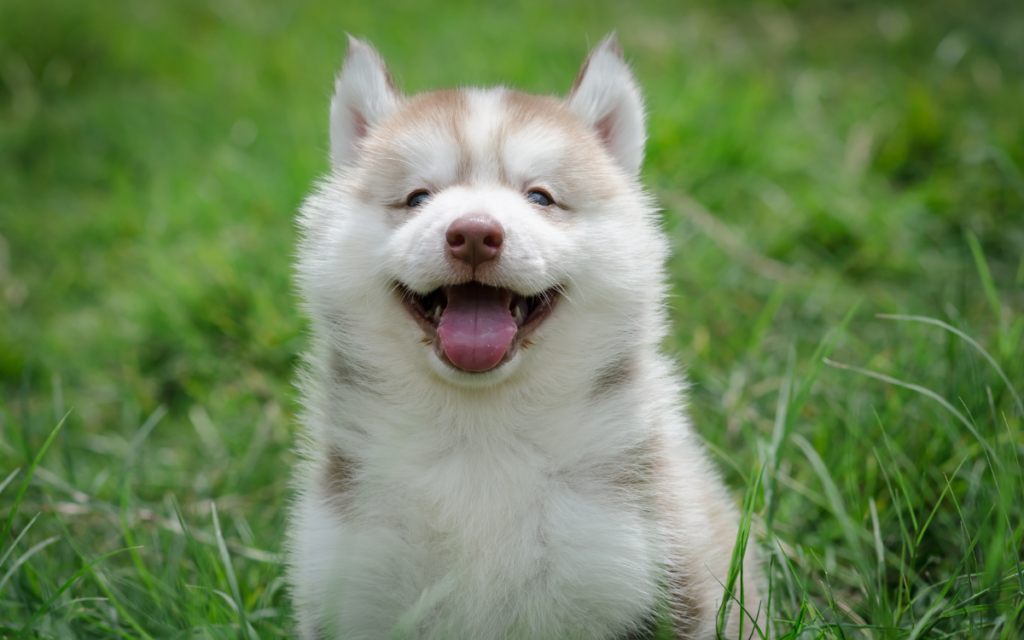

Tips For Healthy Puppy Teeth
- Frequently check your puppy’s mouth and teeth. Keep an eye out for problems like crooked, broken, or crowded teeth, swelling, redness, bumps, bleeding or plaque. Starting this at a young age familiarizes them with having their mouth handled by people.
- Stay on top of the recommended puppy check-ups and vaccination schedule with your veterinarian.
- Make sure they have safe, proper toys (like durable rubber or puzzle toys) for their age. Remember, puppy teeth and brand new adult teeth are more fragile than mature adult teeth. Ask your vet for recommendations if you aren’t sure what kinds of toys are right for your puppy.
- Start brushing their teeth early. Even though their puppy teeth will fall out, brushing during puppyhood will accustom them to the process and save you a lot of future battles.
- Watch for signs of tooth pain. This includes decreased interest in food or treats, dropping food from the mouth while eating, excessive drooling, pawing at the mouth, or resistance to having their mouth touched.
This article has been reviewed by Margo Hennet, DVM.
Margo Hennet, DVM, cVMA, and veterinarian at BARK is a canine nutrition, health, & wellness connoisseur. She has a combined 10 years of experience in clinical medicine, research, and education—that’s 70 dog years of know-how—and graduated from Colorado State University as a Doctor of Veterinary Medicine. She completed specialized training in internal medicine prior to working as a general practitioner in Colorado, has authored peer-reviewed publications and textbook chapters, holds certification in veterinary medical acupuncture, and is a member of the American Academy of Veterinary Nutrition and American Veterinary Medical Association.
Sources
1Reiter, Alexander M. “Dental Disorders of Dogs – Dog Owners.” Merck Veterinary Manual, Merck Veterinary Manual, 10 Feb. 2022, https://www.merckvetmanual.com/dog-owners/digestive-disorders-of-dogs/dental-disorders-of-dogs?query=puppy+teeth.
2Williams, Krista, and Richard Lerner. “Teeth, Teething and Chewing in Puppies.” VCA Animal Hospitals, https://vcahospitals.com/know-your-pet/teeth-teething-and-chewing-in-puppies.
3“Wiggs’s Veterinary Dentistry: Principles and Practice.” Edited by Heidi Lobprise and Jonathan R Dodd, Google Books, John Wiley & Sons, 2018, https://books.google.com/books?id=aIR8DwAAQBAJ&pg=PA63&source=gbs_toc_r&cad=3#v=onepage&q&f=false.
4Lundgren, Becky. “Retained Baby Teeth in Dogs and Cats Need Surgical Extraction.” Veterinary Partner, VIN, 5 May 2020, https://veterinarypartner.vin.com/default.aspx?pid=19239&id=4952450.

